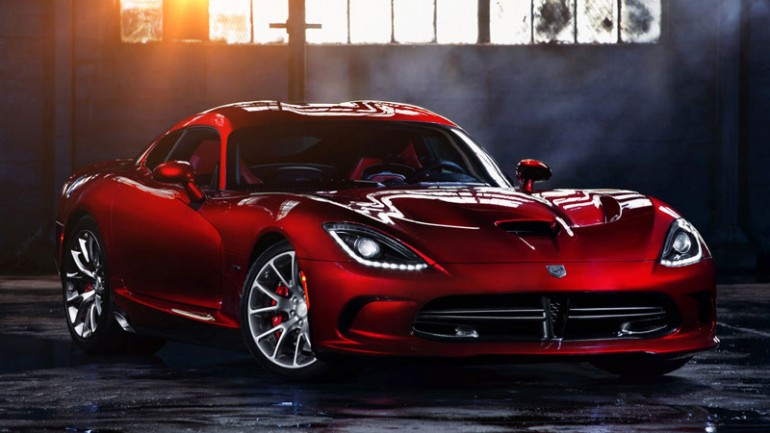Thursday, April 19, 2012
Monstrous new SRT (Dodge) Viper at New York Motor Show
After a period when financial crisis threatened the very existence of Chrysler’s SRT performance brand, the company came back to the New York Motor Show with a fitting flagship, the brand-new Dodge... sorry - SRT Viper and Viper GTS. The original Viper was an outrageous and unsubtle statement of muscle-car intent that unfortunately was unable to hide its uncouth truck-based roots. A loud and powerful beast that featured a comically small cockpit, no particular interest in going around corners and the torsional stiffness of a blancmange. The statement of intent remains but this seventh incarnation is a much-refined beast.
The defining elements remain of course - the front-mid mounted 8 liter V10, the side-mounted exhausts, the massive front wheel-arch vents and the rear-biased cockpit - but the design is much sleeker and more coherent with an Italian flair to the front fascia and integration of the snake-eye headlight clusters. The Viper was always a striking vision but the latest version is almost pretty ... almost.
If the design of the exterior is an improvement, the quality of the interior is a revelation. Ergonomics have advanced significantly with increased legroom, increased seat travel and, for the first time, seat height adjustment. Standard high-performance racing seats from Sabelt, Ferrari’s seat-maker, feature a lightweight Kevlar/fiberglass shell and generous bolsters, and in the GTS virtually all surface are beautifully trimmed in stitched leather. There’s even a built-in cubby hole for your iPad.
These days any car with race pretensions must feature a trick dashboard. Designed specifically for the 2013 SRT Viper, a new 7-inch, full-color, customizable instrument cluster display uses a full-time analog tachometer readout in the center. Drivers have a wide range of custom and personal options such as an additional digital speedometer readout just below the tachometer.
The vehicle information is communicated with icons and controlled through a four-way steering-wheel control. The driver can configure the screens to display the information they desire, mixing and matching information. A range of Harman Kardon surround-sound systems with up to 18 speakers complete the cockpit entertainment. Hours of fun and distraction await.
None of this effort would be worth it if performance wasn’t up to snuff and great strides have been made here also. The mighty aluminium 8.4 liter hand-built V-10 engine has been breathed on. Improvements for 2013 include a new lightweight composite intake manifold, high-strength forged pistons, sodium-filled exhaust valves, new catalysts to reduce back pressure and an aluminum flywheel that reduces reciprocating losses. 25 pounds (11 kg) has been shaved from the fully dressed engine.
Preliminary performance ratings for the SRT-engineered V-10 Viper are 640 horsepower (460 kW) and 600 lb.-ft. (814 Nm) of torque - the most torque of any naturally aspirated engine available.
The Tremec six-speed manual transmission has been improved with a shorter throw shifter, closer gear ratios and a final drive ratio that has been shortened to 3.55 from 3.07. Top speed is now achieved through 6th gear with maximum engine speed (redline) at 6,200 rpm.
Power is nothing without chassis control - an area in which the Viper has been traditionally weak. Starting with a stiffer structure that provides 50 percent more torsional rigidity, the chassis of the 2013 SRT Viper benefits from a number enhancements learned through racing efforts with Viper GTS-R and Competition Coupe models.
Major updates include the addition of an aluminum "X" brace under the hood that ties the suspension pickup points to the magnesium cowl super casting and contributes to improved torsional rigidity and stiffness. A new aluminum impact beam at the front of the car contributes to overall mass savings and improved weight distribution while providing excellent crash-worthiness.
Structurally, many areas of the chassis were reworked to take advantage of new materials, reduce thickness in some areas and reshape components for more structural rigidity in others. The result is an overall weight savings of approximately 100 pounds (45 kg). At the rear, the suspension has been re-engineered with the toe link moved forward of the axle for better tow control and dynamic stability.
A new, driver selectable two-mode suspension system, featuring Bilstein DampTronic Select shock absorbers with both street and track settings, is standard on GTS models.
It may seem an anachronistic vehicle in these times but the effort that Chrysler/STR have put into improving the iconic Viper is impressive. One can’t help but root for the success of the hand-built beast from Detroit.
Race versions will once again be competing at this year’s Le Mans 24 hour.
Subscribe to:
Post Comments (Atom)







No comments:
Post a Comment